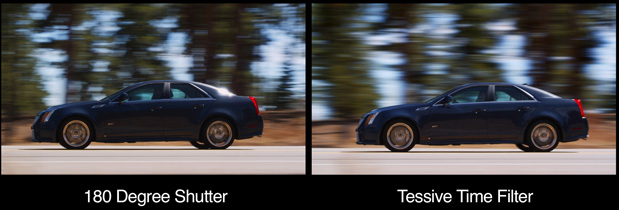When Hobbit Director Peter Jackson surprised theater owners and distributors at CinemaCon this April by screening 10 minutes shot at 48FPS, he ignited a controversy about shutter speeds, changing technology and more. The reaction was mixed at best, with many comparing the look to soap operas and bad television, while Jackson lauded the higher frame rate’s advantages for 3D and its lack “of the strobing, the flicker and the artifacts” present at the standard 24FPS. With better equipment to shoot and screen becoming more widely available, filmmakers like Jackson and James Cameron are exploring higher frame rates for their increased ‘sense of reality’.
Tessive founder Tony Davis thinks there should be more to the conversation.
“When we talk about motion representation, we most often talk about frame rate, but another metric is equally important, and that’s related to what the shutter is doing,” says Davis.
He suggests any talk of FPS should include shutter angle in the next breath. “Shutter angle has at least as significant an impact on viewer perception of motion as frame rate has.” To aid in the understanding of motion representation in cameras, graphs of frequency response, or modulation transfer functions, are used. These plots show the response to real-world optical frequencies any shutter setting will produce. When a shutter setting reduces the camera’s ability to represent fast-moving motion, the plot indicates this clearly as reduced contrast response for higher frequencies.
The change Tessive is advocating is that the underlying assumption that a shutter should be binary–open or closed–needs to be reevaluated. If smooth transitions between open and closed are introduced, the frequency response of the camera can be tuned and optimized. Once the shutter no longer is specified merely by the time it is open, but by the entire waveform it performs during the time of a frame, a wide range of motion representations can be achieved. This, Tessive claims, is at least as important to motion representation as changing the frame rate.
Davis, an engineer specializing in signal processing, began looking at these issues while working on problems related to CAT scans. He realized that lessons learned from these sampling systems could be applied to any problem of signal acquisition. He also discovered that instead of having the shutter transition from dark to light instantly as a digital camera does, he could perfect a mathematically defined exposure curve by smoothly transitioning between the two states.
Proving the math through a series of prototypes, he and partner John Kouns developed an auxiliary shutter in the form of their “Tessive Time Filter(TM)”, a solution that combines an active lcd filter and synching system to eliminate temporal aliasing and other anomalies often created when capturing objects in motion.
With the trend toward larger formats and faster moving images, imperfections onscreen will likely have increased negative effects on the audience’s perception, making it more important than ever that cinematographers consider not only frame rate, but the rest of their shutter system as well.
Tessive is the producer of the Time Filter, a system which fundamentally changes the way motion is captured with cine cameras. Addressing problems previously thought to be intrinsic to the operation of the cameras, the Time Filter is rapidly becoming one of the most talked-about changes to cinema in years. To learn more, visit http://www.tessive.com/
FTC Disclosure: The creation of this article was partially subsidized by Tessive.

